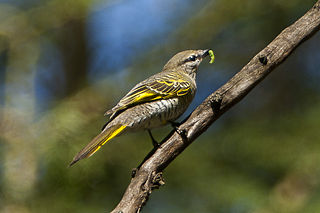
The black cuckooshrike is a species of bird in the cuckooshrike family Campephagidae. The species is closely related to Petit's cuckooshrike and the red-shouldered cuckooshrike, and forms a superspecies with them. It is also known as the African black cuckooshrike.

The western wattled cuckooshrike or Ghana cuckooshrike is a species of bird in the family Campephagidae. It is found in Ivory Coast, Ghana, Guinea, Liberia, and Sierra Leone. Its natural habitats are subtropical or tropical moist lowland forest and subtropical or tropical swamps. It is threatened by habitat loss.

The eastern wattled cuckooshrike or oriole cuckooshrike is a species of bird in the family Campephagidae. It is found in Cameroon, Central African Republic, Republic of the Congo, Democratic Republic of the Congo, Gabon, and Nigeria. Its natural habitat is subtropical or tropical moist lowland forest.

Petit's cuckooshrike is a species of bird in the family Campephagidae. It is found in Angola, Cameroon, Republic of the Congo, Democratic Republic of the Congo, Gabon, Kenya, Nigeria, and Uganda. Its natural habitats are subtropical or tropical moist lowland forest and subtropical or tropical moist montane forest.

The purple-throated cuckooshrike is a species of bird in the family Campephagidae. It is found in Angola, Benin, Cameroon, Central African Republic, Republic of the Congo, Democratic Republic of the Congo, Ivory Coast, Equatorial Guinea, Gabon, Ghana, Guinea, Kenya, Liberia, Mali, Nigeria, Sierra Leone, South Sudan, Tanzania, Togo, Uganda, and Zambia. Its natural habitats are subtropical or tropical dry forest, subtropical or tropical moist lowland forest, and subtropical or tropical moist montane forest.

The New Caledonian cuckooshrike or New Caledonian cicadabird is a species of bird in the family Campephagidae. It is endemic to New Caledonia. Some taxonomists place this species in the genus Analisoma.

The blue cuckooshrike is a species of bird in the Cuckooshrike family, Campephagidae. It is widespread across the African tropical rainforest, from Sierra Leone and Liberia to eastern and south-western Democratic Republic of Congo. Its natural habitats are subtropical or tropical dry forests and subtropical or tropical moist lowland forests.

The pied cuckooshrike is a species of bird in the family Campephagidae. It is endemic to Indonesia, where it is found in Sulawesi. Its natural habitats are subtropical or tropical moist lowland forest and subtropical or tropical mangrove forest. It is threatened by habitat loss.

The stout-billed cuckooshrike is a species of bird in the family Campephagidae. It is found in the Aru Islands and New Guinea. Its natural habitats are subtropical or tropical moist lowland forest and subtropical or tropical moist montane forest.

The Madagascar cuckooshrike, also known as the ashy cuckooshrike, is a species of bird in the family Campephagidae. The Comoros cuckooshrike is sometimes considered a distinct species.

The Buru cuckooshrike is a species of bird in the family Campephagidae. It is endemic to Indonesia.

The black cicadabird, also known as the New Guinea cuckooshrike or New Guinea cicadabird, is a species of bird in the family Campephagidae. It is found in the Aru Islands and New Guinea. Its natural habitats are subtropical or tropical moist lowland forest and subtropical or tropical mangrove forest.

The black-bellied cuckooshrike or black-bellied cicadabird is a species of bird in the family Campephagidae. It is found in New Guinea. Its natural habitats are subtropical or tropical moist lowland forest and subtropical or tropical moist montane forest.

The Indochinese cuckooshrike is a species of bird in the family Campephagidae. It is found in Cambodia, Laos, Myanmar, Thailand, and Vietnam. Its natural habitats are subtropical or tropical moist lowland forest and subtropical or tropical moist montane forest.

The grey-headed cuckooshrike, also known as the grey-headed cicadabird or black-tipped cicadabird, is a species of bird in the family Campephagidae. It is found in New Guinea. Its natural habitats are subtropical or tropical moist lowland forest and subtropical or tropical mangrove forest.
The Sula cicadabird, also known as the Sula cuckooshrike or Moluccan graybird, is a species of bird in the family Campephagidae. It is endemic to Indonesia.

The cerulean cuckooshrike is a species of bird in the family Campephagidae. It is endemic to the island of Sulawesi in Indonesia. Its natural habitats are subtropical or tropical moist lowland forest and subtropical or tropical moist montane forest. Other common names for this bird include the Sulawesi cuckooshrike, the Celebes cuckooshrike and Temminck's cuckooshrike.

Swinhoe's minivet or the brown-rumped minivet is a bird in the cuckooshrike family, Campephagidae. The species was first described by Robert Swinhoe in 1861.

The Comoro cuckooshrike is a species of bird in the family Campephagidae. It is sometimes considered a subspecies of the Madagascar cuckooshrike.
The north Melanesian cuckooshrike is a species of bird in the cuckooshrike family. It is endemic to the Solomon Islands archipelago. It is considered by some ornithologists to be a subspecies of Coracina caledonica. Its natural habitats are subtropical or tropical moist lowland forests and subtropical or tropical moist montane forests.


















